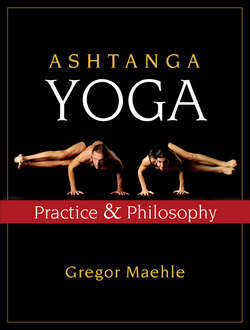Читать книгу Ashtanga Yoga - Gregor Maehle - Страница 111
На сайте Литреса книга снята с продажи.
Vinyasa Two
ОглавлениеExhaling, open the right foot to 90° and turn the left foot in 5° only. Bend the right leg until the knee is positioned exactly above the ankle, which brings the tibia perpendicular to the floor (see Virabhadrasana A in Surya Namaskara B, page 33). It is not a defining factor of the posture to have the femur parallel to the floor: this is achieved when the strength necessary to support such flexibility is developed. Place the right hand on the floor alongside the outside edge of the foot, with fingers pointing in the same direction as the toes. Keeping the base of the big toe grounded, the right knee presses against the right shoulder. This action engages the abductors of the right hip posture is neutralized. Keep tension between the bent knee and the opposite hip to work the groins open. The palm faces down to the floor and the left armpit faces out to the side (and not up to the ceiling). This is achieved by engaging the infraspinatus muscle, which laterally rotates the humerus (arm joint. At the same time, take the left arm over the head to form a diagonal line from the left foot all the way up to the left hand. Beginners may need to increase their stance at this point to achieve this line.
MYTHOLOGICAL BACKGROUND
Perfect World
Lord Subramaniam, second son of Lord Shiva, also known as Skanda the fierce lord of war, once went to visit Lord Shiva and complained that the current world, which was created by Lord Brahma, was imperfect — full of corruption, crime, and injustice. Shiva suggested that he create a better world. Subramaniam then defeated and incarcerated Brahma, and destroyed his world. Then he created his own, better world.
After some time Lord Shiva visited Subramaniam and looked at his perfect world. In it nothing moved or lived or changed, as everything was arrested, frozen in the static state of perfection. There were not even sentient beings, as their essential nature is to strive for perfection and, if perfection is reached, life has come to an end. Liberated beings are not reborn. The Buddha, after reaching Mahaparinirvana, never came back. That is why bodhisattvas avoid perfection: they are thus able to continue to serve others. According to Indian thought, the state of perfection exists only as consciousness, called purusha or atman, which is the seat of awareness. What changes is the transitory world of manifestation, which includes body, mind, egoity, and all objects made up of the gross elements and subtle elementary particles.
Shiva pointed out to Subramaniam that this world was not a world at all, but only a frozen image of perfection. The purpose of a manifest world is to supply beings with the right cocktail of pleasure and pain, which eventually leads to self-knowledge. For this purpose it has to be in constant flux, and hence imperfect. Seeing the flaw in his world, Subramaniam freed Brahma to reinstall his old, imperfect world.
In this posture it is important not to collapse into the hips but to keep them supported. There should be a feeling of buoyancy in the hips and legs away from the floor. Ground the outer arch of the left foot and use it as an anchor to establish an outward rotation in the left thigh, which will lift the left hip back over the right. The right hip joint makes an attempt to dive through under the left one to stretch the right adductor group (see figure 17, page 101) in anticipation of the half-lotus and lotus postures to come.7 The right thigh rotates inward until the lateral rotation that brought us into the bone). This movement does not need to be performed by people whose arm is naturally in this position, which can be assessed by a qualified teacher. Indiscriminate outward rotation may lead to inflammation of the rotator cuff and an infraspinatus that is chronically in spasm.
Keep the shoulders down, away from the ears, by depressing the shoulder girdle using the latissimus dorsi muscle. The shoulder is kept up off the neck by abducting the shoulder blades with the serratus anterior muscle (see figure 9, page 48). Stay in the state of Utthita Parshvakonasana for five breaths.
